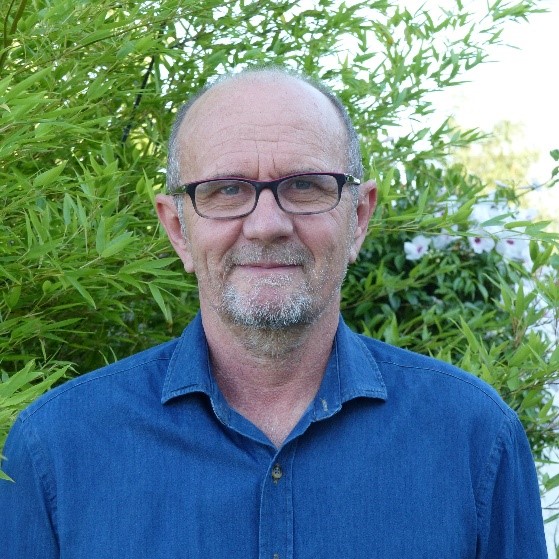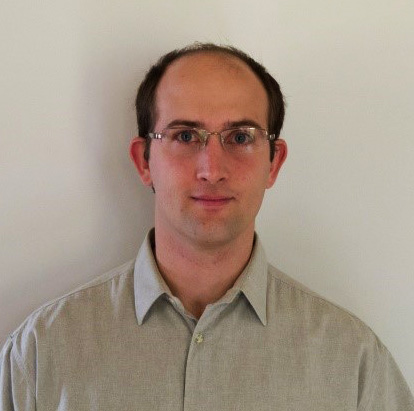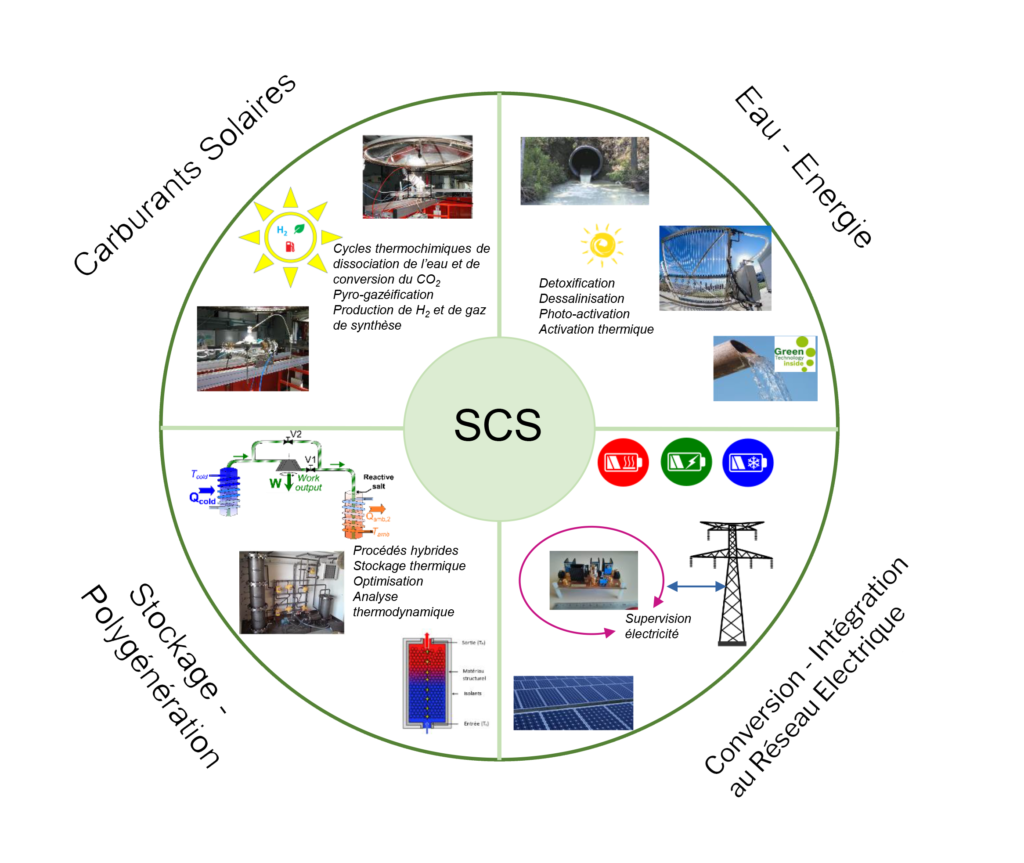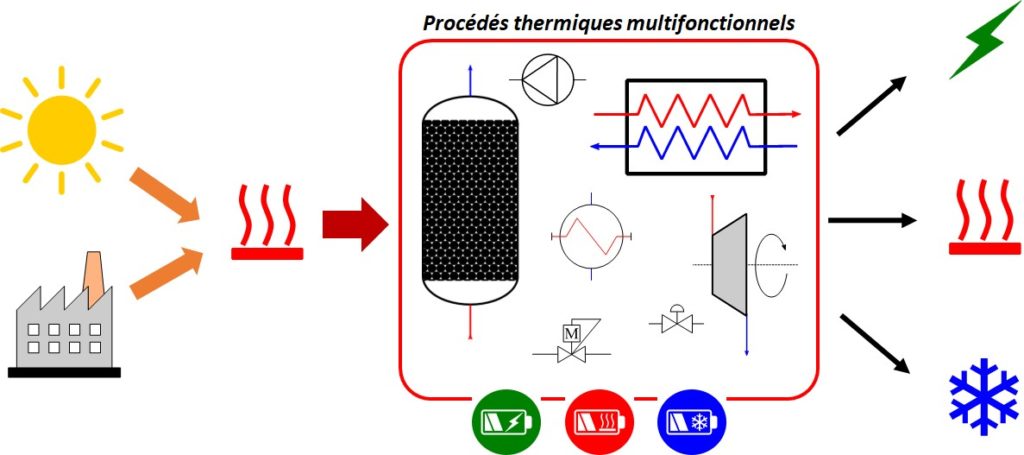In a very generic way, the valorization of solar radiation can be envisaged by a direct use of the energy contained in the photons, or via an intermediate conversion, for example in heat, of this energy. These two options, sometimes complementary, constitute the basic foundation of the research conducted within the SCS axis on Solar Storage and Chemistry. These are expressed in terms of specifically targeted applications. Producing fuels such as hydrogen by reactions initiated at high temperatures by concentrating solar radiation; ensuring the solar photo-activation of a catalyst to improve the sanitary level of effluents before their release into the environment or reuse; developing thermal storage means adapted to a wide range of temperatures and hybrid thermodynamic cycles adapted to optimized management of the solar resource; constitute a set of actions having as a common objective to promote processes that are naturally part of the field of solar eco-technologies. The last action carried out concerns the development of means such as power electronics to ensure an effective interconnection between energy flows of solar origin and electrical networks.
Our research is structured in four actions detailed below
Storage and Polygeneration
Energy production and consumption are characterized by high temporal variability, which tends to increase. At the same time, energy vectors are diversifying in order to best meet energy needs. Thus, the objective is to develop multifunctional systems integrating a storage function and based on the coupling of hybrid thermodynamic cycles. The approach consists in designing and optimizing energy conversion and storage systems in which it is necessary to understand and control the dynamics of coupled irreversible phenomena related to heat and matter transfers, and chemical or phase change kinetics, and to optimize their operation at the system scale.
Activities :
Eco-design, analysis and optimization of solar energy conversion systems for heat, cold and mechanical energy production.
Optimization of thermal storage coupled with thermodynamic cycles.
High temperature thermal storage systems for concentrated solar power.
Characterization and modeling of coupled heat and mass transfers in the presence of an internal source.
2nd principle analysis.
Solar Fuels
The action carried out on solar fuels relates to the production of hydrogen and syngas via the solar thermochemical route. Indeed, it is possible to produce synthetic fuels from water and CO2 or from carbonaceous materials thanks to different endothermic reactions at high temperatures obtained by concentration of solar radiation. The contribution of solar energy to provide the enthalpy of these reactions allows the chemical storage of this variable energy. Applications include the conversion of carbonaceous feedstocks, the thermochemical water splitting to H2, CO2 valorization to energy carriers, and solar metallurgy. The work couples the development of reactive materials and multiphase solar reactors associated with multi-scale modeling.
Activities :
Hydrogen production from carbonaceous feedstocks.
Thermochemical water splitting to H2.
Recycling and valorization of CO2 for the production of synthetic fuels.
Water – Energy
The action carried out proposes to bring sustainable solutions, based on the use of the solar resource, for the desalination or the decontamination of water for recovery, reuse or remediation. Our approach combines process engineering, photoreactor engineering and materials engineering, based on an experimental approach and modeling of phenomena involving kinetics, heat and matter transfers. Two families of processes are developed. Advanced oxidation processes such as photo-oxidation, Fenton/photo-Fenton processes which consist in activating a primary oxidant or a photo-catalyst by UV or visible radiation, in order to produce radical species, to eliminate in situ pathogens and micropollutants. Separation processes that consist in extracting recoverable water under the effect of a concentration or pressure gradient (direct osmosis, reverse osmosis) or a temperature gradient (evaporation/condensation).
Activities :
Detoxification and disinfection of effluents, natural waters (saline, aquaculture).
Desalination of sea or brackish water by solar processes.
Generation of radical species in photoreactor.
Modeling of coupled phenomena.
Interaction des convertisseurs et du réseau électrique
Solar Energy Flow Conversion System for Grid Integration
The Solar Energy Flow Conversion System for Integration into the Electrical Grid action focuses on the integration into the electrical grid of renewable energy sources (PV, CPV, Wind, Hydraulic) and storage systems, regardless of their form (chemical, mechanical, thermal). The electrical interface systems between the process(es) (e.g. PV, thermal, H2) and the electrical network (RTE/Enedis) must allow a conversion leading to an optimal integration of the energy produced. The developed converters couple power electronics structures, electrical machines, supervision algorithms and include fault detection and identification techniques. These converters ensure the quality of the injected energy but also the stability of the electrical network, and also allow its resilience towards external disturbances. The structures studied are also intended to meet strong constraints such as integration, weight or volume/power ratio and power transients. Constraints found in particular applications such as embedded (transport, air and space), maritime and systems in complete or partial autonomy (RE installation in self-production, self-consumption or with partial network injection).
Activities :
Power electronics
Digital electronics
Supervision of conversion structures
Identification and detection of electrical faults.
Head of the theme
Deputy Head of the theme

Vincent Goetz
Directeur de Recherche CNRS

Sylvain Rodat
Chargé de Recherche CNRS
Members in the theme
| Nom de la Thématique | Stockage et Chimie Solaire (SCS) |
|---|---|
| Responsable | Vincent GOETZ |
| Adjoint•e•s | Sylvain RODAT |
| Nombre de C/EC/IR | 19 (5 C/ 10 EC/ 4 IR) |
| Nombre de Doctorants/Post-docs/ATER/... | 7 (6 doctorant•e•s/ 1 Postdoc) |
| Membres permanents de la Thématique et statut (IR, CR, DR, MCF, PR - HDR) | Stéphane ABANADES, DR2 CNRS |
| Membres non-permanents de la Thématique et statut (Doctorant, Post-doctorant, ATER, …) | Sarra ARFAOUI, CDD Doct. |





